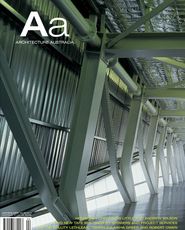THE ENVIRONMENT DESIGN GUIDE IS TEN YEARS OLD. SO HOW MIGHT THE PROFESSION TURN THIS INFORMATION INTO KNOWLEDGE, AND KNOWLEDGE INTO ACTION? CERIDWEN OWEN CONSIDERS THE EXPANDING UNIVERSE OF ESD.
IN FEBRUARY THIS year, the Environment Design Guide, or “EDG(e)” as it is commonly known, celebrated its tenth birthday. Such milestones inevitably induce an atmosphere of reflection, so it seems timely to contemplate where EDG and the sustainability agenda have come in the last ten years, and what the next ten years might bring.
A decade is a milestone in any field, but for “sustainability” it represents more than half a lifetime. Within architecture, sustainability has barely reached adolescence since its formal adoption by the profession in October 1993 as the Declaration for Interdependence for a Sustainable Future on the back of the UIA/AIA World Congress declaration in the same year. The inaugural issue of EDG, only sixteen months later, therefore, was born into a fledgling field.
Despite this nascent context, the vision and mission of the guide have changed little in its ten-year history. EDG was initiated by the Natural Environment and Energy Group to support the implementation of the objectives of the RAIA’s Environment Policy. The main focus of this effort was the provision of accurate, relevant and accessible information on sustainability. This remains the core aim of the guide, with the only significant change being the expansion of its territory beyond architectural boundaries with the virtual move from the RAIA to the auspices of the Building Design Practitioners (BDP) in June 1999.
As an information guide, EDG stands up to scrutiny and fulfils its claim to be “the most comprehensive single source of information on environmental design issues specifically tailored to the needs of Australia’s planning and building design professionals”. In a world of greenwash, it presents welcome relief, with independently refereed and regularly reviewed papers from industry, practice and academia. The guide also reflects the dynamic and diverse nature of the field of sustainability, with papers ranging from the detailed and pragmatic to the general and esoteric.
EDG is an extremely robust information resource, but is it effective in its mission to advance sustainability within practice? This is a difficult question, and the most likely answer is both yes and no. On the positive side, it has perpetuated itself in a field where many other resources and organizations have blossomed and waned. This is a distinct achievement given the overwhelming quantity of tools and information that have been made available to building design professionals in the last ten years. Subscription rates paint a more variable picture, however. Numbers within the architecture profession are relatively healthy, although static, while there has been a very marginal uptake within other disciplines. This suggests that EDG remains primarily relevant to building designers rather than engineers, landscape architects, planners or quantity surveyors. Even within the architecture profession, anecdotal reports indicate that its primary failing is its lack of use as a tool to actively inform practice. The information is there, but is it being used to its full potential?
Information is not knowledge and knowledge does not necessarily instigate action. This is perhaps the foremost issue for the sustainability agenda, and it is one that extends far beyond the boundaries and mandate of the Environment Design Guide. The problems surrounding global warming are well documented, and all but the most virulent sceptics accept it as scientific certainty. Yet, despite global political support for sustainability and numerous international, national and local sustainability initiatives, greenhouse gas emissions are still on the increase. There appears to be a widespread apathy towards sustainability as a repercussion of the immensity of the problem and the perceived insignificance of any individual effort. Furthermore, perhaps we have become numbed by the series of disaster scenarios presented to us since the publication of Rachel Carson’s Silent Springin 1962, and since the first worldwide oil crisis in the early seventies.
Within the more specific context of the building design professions, the contribution of the built environment to the global environmental agenda instils both lethargy and action. Buildings and their associated resources are estimated to contribute almost one quarter of Australia’s greenhouse gas emissions and 20–30 per cent of all solid waste to landfill. On the other hand, the turnover of the existing building stock is less than two per cent per annum, and in the competitive world of building design, architects claim an even smaller slice of the pie. Moreover, the extent to which architects can influence environmental outcomes is questionable, since lack of client demand and greater financial cost are generally seen to be the major barriers to the implementation of sustainability initiatives in practice.
Nevertheless, the debate concerning the sustainability of the built environment and the role of the architect in directing change is intensified beyond such relative quantitative impacts. The built environment is not only a major contributor to environmental degradation, but it is also a legacy that must be endured by future generations. Furthermore, at the level of the profession, the architect’s role is greater than the physical function of building designer, extending to the symbolic realm of ambassador and critic. In this way, while the role of the individual designer might appear constrained, the role of the profession is more widely recognized as making significant contributions to the sustainability debate.
So what does this mean for the future of the Environment Design Guide, and more broadly for the future of sustainability within architecture? Some tentative suggestions follow. Firstly, now that we have made substantial inroads into developing quality information resources such as EDG, the focus should turn towards education. This is not to suggest that the RAIA or the BDP have shied away from education; however, there are opportunities to intensify these efforts within formalized systems such as university education and continuing professional development. EDG is a wealth of information, but it must be transformed into knowledge.
The second key area of opportunity lies with galvanizing this knowledge into action. This appears as a core principle within the RAIA’s environment policy, as part of its five-point plan for environmental change. To date, the profession’s efforts in this area have relied on individual action through voluntary codes of conduct. Almost twelve years have passed since the implementation of the profession’s voluntary code of conduct, and while many individual positive changes have occurred, at the level of the entire profession there is evidence of the collective global apathy. This leads many environmentalists to argue that the only possibility for substantial and widespread change lies with legislative measures such as the recent changes to the BCA and the numerous local government initiatives within planning schemes. Such changes do force action at a universal level, but this action can only ever be directed towards the lowest common denominator.
ESD is an expanding universe and it cannot be locked down to simplistic building regulations. There is much to be gained from such moves, but it is not where the architecture profession’s efforts should be focused. The issue of individual responsibility through voluntary codes of conduct and through self-education will remain, but the profession also needs to promote collective action at a visionary level if it is to counter tendencies towards individual apathy. Initiatives such as the RAIA’s tsunami taskforce are encouraging as moves towards affirmative action rather than reaction to, or debate on, global environmental and social problems. Hopefully such visionary action is what the next decade will bring, so that as architects we can feel that we are doing more than just tinkering at the “edges”.
DR CERIDWEN OWEN IS A LECTURER IN ARCHITECTURE AT THE UNIVERSITY OF TASMANIA AND A PARTNER WITH CORE COLLECTIVE ARCHITECTS.















